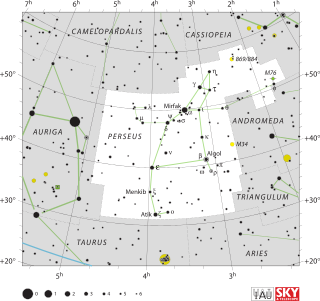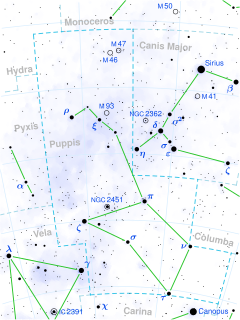
67 Ophiuchi is a class B5 Ib star in the constellation Ophiuchus. Its apparent magnitude is 3.93 and it is approximately 1200 light years away based on parallax. It is considered to be a member of the open cluster Collinder 359.

15 Orionis is a suspected astrometric binary star system in the equatorial constellation of Orion, near the border with Taurus. It is visible to the naked eye as a faint, yellow-white hued star with an apparent visual magnitude of 4.82. The system is approximately 340 light years away from the Sun based on parallax. It is moving further from the Earth with a heliocentric radial velocity of +29 km/s, having come to within 69 light-years some three million years ago.
Zeta Monocerotis, Latinized from ζ Monocerotis, is a single, yellow-hued star in the constellation Monoceros. It has an apparent visual magnitude of 4.33, which is bright enough to be visible to the naked eye. The annual parallax shift as measured during the Hipparcos mission is 3.08 milliarcseconds, which provides a rough distance estimate of 1,060 light years. It is moving away from the Sun with a radial velocity of +30 km/s.

20 Monocerotis is a single star located about 194 light years away from the Sun in the equatorial constellation of Monoceros. It is visible to the naked eye as a faint, orange-hued star with an apparent visual magnitude of 4.92. The star is receding from the Earth with a heliocentric radial velocity of +78 km/s.

HD 103079 is a class B4V star in the constellation Musca. Its apparent magnitude is 4.89 and it is approximately 362 light years away from Earth based on parallax. It is a member of the Lower Centaurus Crux subgroup of the Scorpius–Centaurus Association, a group of predominantly hot blue-white stars that share a common origin and proper motion across the galaxy.

66 Ophiuchi is a solitary variable star in the equatorial constellation of Ophiuchus. It has the variable star designation V2048 Ophiuchi, while 66 Ophiuchi is the Flamsteed designation. This object is visible to the naked eye as a faint, blue-white hued point of light with a baseline apparent visual magnitude of 4.60. It is located approximately 650 light years away from the Sun based on parallax, but is drifting closer with a radial velocity of −13 km/s. The star has a peculiar velocity of 13.1±3.2 km/s relative to its neighbors.

42 Orionis is a class B1V star in the constellation Orion. Its apparent magnitude is 4.59 and it is approximately 900 light years away based on parallax.

1 Pegasi is a triple star system in the constellation Pegasus, located approximately 156 light years away from the Sun based on parallax. It is visible to the naked eye as a faint, orange-hued star with an apparent visual magnitude of 4.09. The system is moving closer to the Earth with a heliocentric radial velocity of −11 km/s.

2 Pegasi is a single star in the constellation Pegasus, located approximately 394 light years away from the Sun based on parallax. It is visible to the naked eye as a faint, red-hued star with an apparent visual magnitude of 4.52. The object is moving closer to the Earth with a heliocentric radial velocity of −19 km/s. It has a magnitude 12.7 visual companion, designated component B, at an angular separation of 30.4″.

31 Pegasi is a single star in the northern constellation of Pegasus. It is visible to the naked eye as a dim, blue-white hued point of light with a baseline apparent visual magnitude of 4.99. It is located approximately 1,600 light years away from the Sun based on parallax, but is drifting closer with a radial velocity of −5.3 km/s.

40 Persei is a wide binary star system in the northern constellation of Perseus. It has the Bayer designation ο Persei, while 40 Persei is the Flamsteed designation. The system is visible to the naked eye as a faint, blue-white hued point of light with an apparent visual magnitude of 4.97. It is located approximately 1060 light years away from the Sun based on parallax, and is drifting further away with a radial velocity of +22 km/s. The system is a member of the Perseus OB2 association of co-moving stars.

HD 63922 is a class B0III star in the constellation Puppis. Its apparent magnitude is 4.11 and it is approximately 1600 light years away based on parallax.

HD 64740 is a class B1.5V star in the constellation Puppis. Its apparent magnitude is 4.63 and it is approximately 760 light years away based on parallax.

NV Puppis, also known as υ1 Puppis, is a class B2V star in the constellation Puppis. Its apparent magnitude is 4.67 and it is approximately 800 light years away based on parallax.

HD 68601 is a class A7Ib star in the constellation Puppis. Its apparent magnitude is 4.75 and it is approximately 4,200 light years away based on parallax.

HD 70555 is a class K2.5II-III star in the constellation Puppis. Its apparent magnitude is 4.83 and it is approximately 1,010 light years away based on parallax.

HD 61831 is a class B2.5V star in the constellation Puppis. Its apparent magnitude is 4.84 and it is approximately 556 light years away based on parallax.

HD 51799 is a class M1III star in the constellation Puppis. Its apparent magnitude is 4.95 and it is approximately 860 light years away based on parallax.

HD 167818 is a class K3II star in the constellation Sagittarius. Its apparent magnitude is 4.66 and it is approximately 760 light years away based on parallax.

21 Sagittarii is a binary star system in the southern zodiac constellation of Sagittarius. It is visible to the naked eye as a faint point of light with a combined apparent visual magnitude of 4.81. The system is located approximately 410 light years away from the Sun based on parallax. It is moving closer to the Earth with a heliocentric radial velocity of −11.80 km/s.








